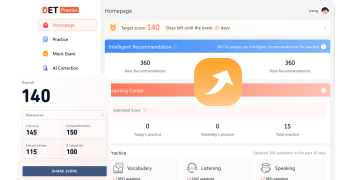Duolingo İngilizce Testi'nin "Oku, Sonra Konuş" Bölümünde Ustalaşmak
Duolingo İngilizce Testi, İngilizce yeterliliğinizi çevrimiçi olarak değerlendirmek için uygun ve ekonomik bir yoldur. Diğer standart testlerden farklı olarak, Duolingo İngilizce Testi seviyenize ve yeteneklerinize uyum sağlayan benzersiz bir formata sahiptir. Testin en zorlayıcı ve önemli bölümlerinden biri, bir teşvik metnini okuduktan sonra bir konu hakkında 90 saniye konuşmanız gereken “Read, Then Speak” bölümüdür.
Bu makalede, bu bölümde başarılı olmanıza ve Konuşma ve Üretim alt puanlarınızı artırmanıza nasıl yardımcı olabileceğimizi göstereceğiz.
Kapsayacaklarımız:
- “Read, Then Speak” Formatını Anlamak
- Cevap Vermeye Hazırlanmak
- Cevabınızı Yapılandırmak
- Cevabınızı Sunmak
- Cevabınızı Geliştirmek
- Örnek Bir Soru ve Demo Cevabı Dahil Etmek
- Uygulama İpuçları ve Kaynakları

“Read, Then Speak” Formatını Anlamak
“Read, Then Speak” bölümü, Duolingo İngilizce Testindeki dört konuşma görev türünden biridir. Size "Aşağıdaki konu hakkında 90 saniye boyunca konuşun." demektedir.
Bu soru tipinde, ekranda yazılı bir teşvik metni göreceksiniz. Teşvik metnini okumak ve cevabınızı hazırlamak için 20 saniyeniz olacak. Ardından, test otomatik olarak kayıt ekranına geçecek ve burada cevabınızı konuşmak için 90 saniyeniz olacak. Konuşurken hala teşvik metnini görebileceksiniz.
Teşvik metni genellikle kişisel bir deneyim, fikir veya tercihiniz hakkında konuşmanızı isteyecektir. Örneğin:
- En sevdiğiniz restoran hakkında konuşun.
- Zor bir karar vermek zorunda kaldığınız bir zamanı tartışın.
- Sevdiğiniz bir hobiyi tanımlayın.
Teşvik metni ayrıca cevabınızı yönlendirecek bazı madde işaretleri içerecektir. Örneğin:
- Nerede?
- Ne tür yemekler sunuyor?
- Ne kadar sık oraya gidiyorsunuz?
- Neden bu sizin favoriniz?
Cevabınız iki alt puan üzerinden değerlendirilecektir: Konuşma ve Üretim. Konuşma, soruya ne kadar iyi tepki verdiğinizi ve fikirlerinizi ifade ettiğinizi ölçer. Üretim ise kelime dağarcığını ve dil bilgisi kurallarını ne kadar iyi kullanarak açık ve doğru iletişim kurduğunuzu ölçer.
Cevap Vermeye Hazırlanmak
Başarılı bir cevap için anahtarlardan biri teşvik metnini hızlıca anlamak ve kısa zaman diliminde düşüncelerinizi organize etmektir. İşte hazırlık yapmanıza yardımcı olacak bazı stratejiler:
- Teşvik metnini dikkatlice okuyun ve ana konuyu ve alt konuları belirleyin. Örneğin, teşvik "En sevdiğiniz restoran hakkında konuşun." ise, ana konu en sevdiğiniz restoran ve alt konular nerede olduğu, ne tür yemekler sunduğu, ne kadar sık gittiğiniz ve neden favoriniz olduğudur.
- Ana konuyla ilgili belirli bir örneği düşünün. Örneğin, en sevdiğiniz restoran evinize yakın bir Tayland yeri ise, arkadaşlarınız veya ailenizle oraya gittiğiniz unutulmaz bir zamanı düşünün.
- Cevabınızı yapılandırmak için madde işaretlerini kılavuz olarak kullanın. Örneğin, en sevdiğiniz restoranı tanıtarak başlayabilir, ardından sırasıyla her madde işareti hakkında konuşarak ana noktayı özetleyen bir sonuçla bitirebilirsiniz.
- Hazırlık süresini etkili bir şekilde kullanın. Ana noktalarınızı hatırlamanıza yardımcı olacak bazı anahtar kelimeler bulabilirsiniz. Ayrıca, güvenle başlamak için cevabınızın ilk cümlesini söyleme pratiği yapabilirsiniz.
Cevabınızı Yapılandırmak
Açık ve mantıklı bir yanıt yapısı, cevabınızı sorunsuz ve tutarlı bir şekilde sunmanıza yardımcı olacaktır. İşte yanıtınızı yapılandırmanıza yardımcı olacak bazı ipuçları:
- Bir giriş, bir gelişme ve bir sonuç oluşturun. Girişiniz ana konuyu kısaca tanıtmalı ve ana noktanızı belirtmelidir. Gelişme aşamasında ana noktanızı her alt konuyu detaylı bir şekilde ele alarak geliştirin. Sonuç, ana noktayı özetlemeli ve son bir yorumla bitmelidir.
- Fikirlerinizi ve cümlelerinizi bağlamak için geçiş kelimeleri ve ifadeler kullanın. Örneğin, “first”, “second”, “third”, “next”, “then”, “finally”, “also”, “however”, “for example”, “in conclusion” gibi kelimeler kullanabilirsiniz.
- Teşvik metninin tüm bölümlerini ele alın. Hiçbir madde işaretini atlamadığınızdan veya görmezden gelmediğinizden emin olun. Bir alt konu hakkında söyleyecek bir şeyiniz yoksa, bunu kısaca belirterek devam edebilirsiniz. Örneğin, “I don’t go there very often, but when I do, I always enjoy it.” diyebilirsiniz.
- Konuya odaklanın. Kısa yollara sapmayın veya ilgisiz ayrıntılara girmeyin. Konudan sapıyorsanız, kendinizi ana noktaya ve madde işaretlerine geri getirin.
Cevabınızı Sunmak
Teslimatınız içeriğiniz kadar önemlidir. İşte cevabınızı net ve akıcı bir şekilde sunmanıza yardımcı olacak bazı teknikler:
- Doğal ve net konuşun. Normal bir konuşma hızında ve ses seviyesinde konuşun. Çok hızlı veya çok yavaş, çok yüksek veya çok düşük sesle konuşmayın. Kelimelerinizi doğru telaffuz edin ve mırıldanma veya kelimeleri gevelemekten kaçının.
- Çeşitli kelimeler ve yapılar kullanın. Aynı kelimeleri veya cümleleri tekrar tekrar kullanmayın. Aynı fikri farklı şekillerde ifade etmek için eş anlamlılar, zıt anlamlılar veya paraphraseler kullanın. Yeterlilik ve doğruluğunuzu göstermek için geniş bir kelime dağarcığı ve gramer yapıları kullanın.
- Zamanınızı iyi yönetin. Cevabınızı konuşmak için 90 saniyeniz var, bu süre teşvik metnini ve madde işaretlerini ele almak için yeterlidir. Çok uzun veya çok kısa konuşmayın. Cevabınızı zaman dolmadan bitirirseniz, ana noktanızı daha fazla detay veya örnekle genişletebilirsiniz. Zamanınız tükenirse, cevabınızı hızlıca toparlayabilirsiniz.
- Çeşitli tonlama ve vurgu kullanın. Tekdüze veya monoton bir sesle konuşmayın. Anlam ve duyguyu iletmek için perde, hacim ve streste değişiklikler kullanın. Cümlelerinizde önemli kelimeleri veya ifadeleri vurgulayın. Soruları ve ifadeleri belirtmek için yükselen ve düşen tonlama kullanın.
Yanıtınızı Geliştirmek
Cevabınızı öne çıkarmak ve değerlendiricileri etkilemek için bazı stratejiler kullanabilir ve konuşma becerilerinizi gösterebilirsiniz. İşte bunun yollarından bazıları:
- Rhetorik sorular kullanın. Rhetorik sorular, kendinize veya dinleyiciye sorduğunuz, ancak yanıt beklemediğiniz sorulardır. Dinleyiciyi meşgul etmek, düşüncelerinizi ifade etmek veya bir noktayı vurgulamak için kullanılırlar. Örneğin, “Who doesn’t love Thai food, right?” or “What could be better than that?” diyebilirsiniz.
- Anekdotlar veya hikayeler kullanın. Anekdotlar veya hikayeler, kişisel deneyimlerin veya olayların kısa ve ilginç anlatımlarıdır. Bir noktayı açıklamak, örnekler sunmak veya mizah katmak için kullanılırlar. Örneğin, “One time, I ordered the spiciest dish on the menu, and I regretted it so much. My mouth was on fire, and I had to drink three glasses of water to cool it down.” diyebilirsiniz.
- Görüşler veya hisler kullanın. Görüşler veya hisler, bir konu hakkındaki kişisel görüşleriniz veya duygularınızdır. Kişiliğinizi, perspektifinizi veya tutumunuzu göstermek için kullanılırlar. Örneğin, “I think Thai food is the best cuisine in the world.” or “I feel so happy and relaxed when I go to my favorite restaurant.” diyebilirsiniz.
Örnek Bir Soru ve Demo Cevabı
Tartıştığımız ipuçlarını ve stratejileri uygulamanız için daha iyi bir fikir vermek adına, “Read, Then Speak” bölümü için bir örnek soru ve demo cevaba bakalım.
Örnek Soru:
Discuss a time when you had to make a difficult decision.
What was the situation?
What choices were available to you?
Why did you make the decision you did?
Demo Cevap:
Well, I’d say one of the toughest decisions I’ve ever had to make was figuring out where I wanted to go to college after I finished up high school. I had gotten accepted to a few different schools and it definitely wasn’t an easy choice to make.
Let’s see, first off, I should probably give you some background real quick on the different colleges I got into. There was this small liberal arts college pretty close to home that I applied to. It was a nice little school. Then there was this huge state university that was like 5 hours away – it was really big with tons of students. And last, I applied to this Ivy League school all the way on the other side of the country. I had worked really hard to get awesome grades and test scores in high school so I could have some good options to choose from.
So each school had their own pros and cons that I had to think about. The small college was nearby and I already knew some kids going there. But it didn’t have the big name like the Ivy League did. The state school was a lot more affordable but it was so big I worried I wouldn’t get enough personal attention from professors. And the Ivy League school was super prestigious, but way more competitive and expensive too.
After visiting all 3 campuses, I decided the small liberal arts college was the best option for me. I really liked the small class sizes and how tight-knit the community felt. They also gave me a great financial aid package that made it possible to afford. I knew I’d get to work closely with professors and get individualized attention there, and that was huge for me.
So in the end, I went with my gut telling me the small school was the right call. I didn’t want to pass up the chance to really get mentored and be part of a community just because the Ivy League name carried more weight. And I’m stoked with my choice – I’ve gotten to have experiences at this school I don’t think I would’ve had anywhere else. So for me, I’m happy with my decision.
Pratik İpuçları ve Kaynaklar
Konuşma becerilerinizi geliştirmek ve “Read, Then Speak” bölümü için hazırlık yapmak için en iyi yol düzenli ve sürekli pratik yapmaktır. İşte pratik yapmanıza yardımcı olacak bazı yöntemler ve kaynaklar:
- Test ortamını simüle edin. Gerçek test koşullarını mümkün olduğunca yeniden yaratmaya çalışın. Bir web kamerası ve mikrofonu olan bir bilgisayar kullanın ve testi almak için sessiz ve rahat bir yer bulun. Teşvik metnini okumak için 20 saniye ve cevabınızı konuşmak için 90 saniye ayarlayın. Kendinizi kaydedin ve performansınızı dinleyin. Güçlü ve zayıf yönlerinizi belirleyin ve bunları geliştirmek için çalışın.
- Çevrimiçi kaynakları kullanın. İngilizce konuşma becerilerinizi geliştirmek ve Duolingo İngilizce Testine hazırlık yapmak için birçok çevrimiçi kaynak mevcuttur. Örneğin, test formatı, puanlama ve ipuçları hakkında daha fazla bilgi edinmek için resmi DET web sitesini kullanabilirsiniz. Ayrıca, teste aşina olmak için Duolingo İngilizce Testi uygulama soru bankamızı kullanabilirsiniz.
Buraya tıklayın daha fazla DET Hazırlık Stratejileri
DET hakkında ipuçları mı arıyorsunuz? Burada bulun: https://www.detpractice.com/category/pro-test-tips/
Bugün ücretsiz olarak DET soru bankamıza kaydolarak çalışmaya başlayın.






